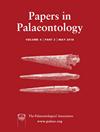An abundant sea anemone from the Carboniferous Mazon Creek Lagerstӓtte, USA
IF 2.3
2区 地球科学
Q1 PALEONTOLOGY
引用次数: 1
Abstract
Sea anemones (Actiniaria) are among the rarest of recognized fossil organisms, even rarer than jellyfish. Here we demonstrate that the most abundant fossil in the Pennsylvanian Mazon Creek Lagerstätte of Illinois, Essexella asherae, is an infaunal or semi‐infaunal anemone. Essexella is redescribed based on a taphonomic analysis of thousands of specimens, as well as associated medusae and trace fossils. Specimens of Essexella (also known as the ‘blobs’) were long believed to be medusae, but we reassign Essexella to the order Actiniaria and reinterpret the putative jellyfish Reticulomedusa as the pedal or oral disc of Essexella. We also implicate Essexella as a producer of Conostichus, a widespread plug‐shaped trace fossil that occurs in coeval strata in the same region. Radiate structures comparable to the bases of Conostichus and the ichnofossil Bergaueria, as well as the pedal discs of modern anemones, characterize Reticulomedusa. Bona fide medusae are present in the Mazon Creek biota, and include Anthracomedusa turnbulli and Octomedusa pieckorum, whereas the soft‐bodied fossil Lascoa mesostaurata is referred to Problematica.产于美国石炭纪亚马孙河Lagerstӓtte的一种丰富的海葵
海葵(Actiniaria)是公认的最稀有的生物化石之一,甚至比水母还稀有。在这里,我们证明了伊利诺斯州宾夕法尼亚河Lagerstätte中最丰富的化石,Essexella asherae,是一种水栖或半水栖海葵。根据对数千个标本的分类分析,以及相关的水母和痕迹化石,对埃塞塞拉进行了重新描述。Essexella的标本(也被称为“blobs”)长期以来被认为是水母,但我们将Essexella重新分配到Actiniaria目,并将假定的Reticulomedusa水母重新解释为Essexella的足部或口盘。我们还认为Essexella是Conostichus的生产者,Conostichus是一种广泛存在于同一地区的同古地层中的塞状痕迹化石。辐射结构与Conostichus和鱼化石Bergaueria的基部相当,以及现代海葵的脚盘,是Reticulomedusa的特征。真正的水母科存在于亚马逊河生物群中,包括Anthracomedusa turnbulli和Octomedusa pieckorum,而软体化石Lascoa mesosatata则被称为Problematica。
本文章由计算机程序翻译,如有差异,请以英文原文为准。
求助全文
约1分钟内获得全文
求助全文
来源期刊

Papers in Palaeontology
PALEONTOLOGY-
CiteScore
4.50
自引率
4.30%
发文量
55
期刊介绍:
Papers in Palaeontology is the successor to Special Papers in Palaeontology and a journal of the Palaeontological Association (www.palass.org). The journal is devoted to the publication of papers that document the diversity of past life and its distribution in time and space.
Papers in Palaeontology is devoted to the publication of papers that document the diversity of past life and its distribution in time and space. As a sister publication to Palaeontology its focus is on descriptive research, including the descriptions of new taxa, systematic revisions of higher taxa, detailed biostratigraphical and biogeographical documentation, and descriptions of floras and faunas from specific localities or regions. Most contributions are expected to be less than 30 pp long but longer contributions will be considered if the material merits it, including single topic parts.
The journal publishes a wide variety of papers on palaeontological topics covering:
palaeozoology,
palaeobotany,
systematic studies,
palaeoecology,
micropalaeontology,
palaeobiogeography,
functional morphology,
stratigraphy,
taxonomy,
taphonomy,
palaeoenvironmental reconstruction,
palaeoclimate analysis,
biomineralization studies.
 求助内容:
求助内容: 应助结果提醒方式:
应助结果提醒方式:


